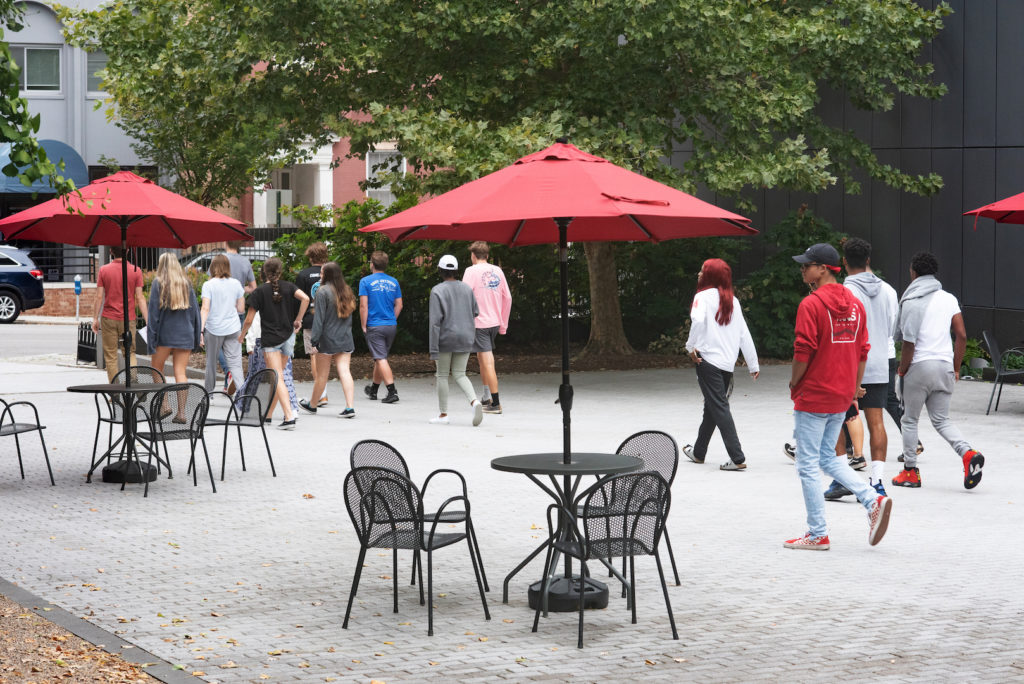Nearby the MCHC
The Maryland Center for History and Culture is proud to be a part of Baltimore’s Mount Vernon cultural district. The neighborhood is home to a vibrant mix of art museums, music venues, theaters, colleges and universities, and historical landmarks. For your convenience, we have listed notable nearby attractions and dining and hotel accommodations to round out your experience with us.

Explore More
hotels
We are pleased to refer visitors who need accommodations to the two hotels listed below. Both are a short walk (five minutes or less). Use these links to make your reservation and receive a discounted price on your booking:
Hotel Indigo – 24 W. Franklin Street, Baltimore, MD 21201 – 410-625-6200
Hotel Revival – 101 W. Monument Street, Baltimore, MD 21201 – 410-727-7101
restaurants
Mount Vernon Marketplace – located directly next door at 520 Park Avenue. Approximately 12 locally owned shops serving a variety of food.
Marie Louise Bistro – 340. N. Charles Street. French, Italian, Mediterranean cuisine.
Akbar Restaurant – 823 N. Charles Street. Indian cuisine.
Lexington Market – 400 W. Lexington Street. A Baltimore landmark since 1782. Seafood, sandwiches, international food booths.
Neighborhood points of interest
Mount Vernon Place – A park-like square centered at the intersection of Charles and Monument streets featuring fountains, sculpture, and marble balustrades. A great place to lunch, relax, or people watch.
The Washington Monument – At the center of Mount Vernon Place, this 178-foot column of white Cockeysville marble was designed by Robert Mills. Construction began in 1819 and the Enrico Causici statue of George Washington was installed on the top in 1829. It is the first monument erected in honor of the first president of the United States.
The Walters Art Museum – In 1931, retired railroad magnate Henry Walters bequeathed his extensive art collection to the people of Baltimore. Centered in a palazzo-like building at the southwest corner of Mount Vernon Place, the museum displays an amazing collection of art, ranging from Egyptian sarcophagi to Impressionist masterpieces.
The Peabody Institute and Library – George Peabody, a banker and the “father of modern philanthropy,” lived in Baltimore between 1816 and 1836. His legacy to the city is the world-renowned Peabody Conservatory of Music and the George Peabody Library.
The Garrett-Jacobs Mansion (Engineers’ Club) – Designed by noted architects Stanford White and John Russell Pope, the first section was built in 1872 for B&O Railroad President John Garrett. Among its notable features are the original carved spiral staircase topped by a Tiffany glass dome, paneled library, and an enormous ballroom.
Baltimore Basilica – The Basilica of the Assumption – Designed by Benjamin Latrobe and completed in 1821, the Basilica is one of the finest examples of neoclassical architecture in the world, and the nation’s first Catholic cathedral.
The Enoch Pratt Free Library – Funded by one of Baltimore’s best known philanthropists, Enoch Pratt, the imposing white marble building at Cathedral and Mulberry streets, opened in 1886 and is one of the oldest free public libraries in the country.
Eubie Blake Cultural Center – James Hubert (Eubie) Blake was born in Baltimore on 1887. A composer, lyricist, and pianist, he was a major figure in the revival of ragtime and early jazz, returning them to prominence as true American musical genres.

